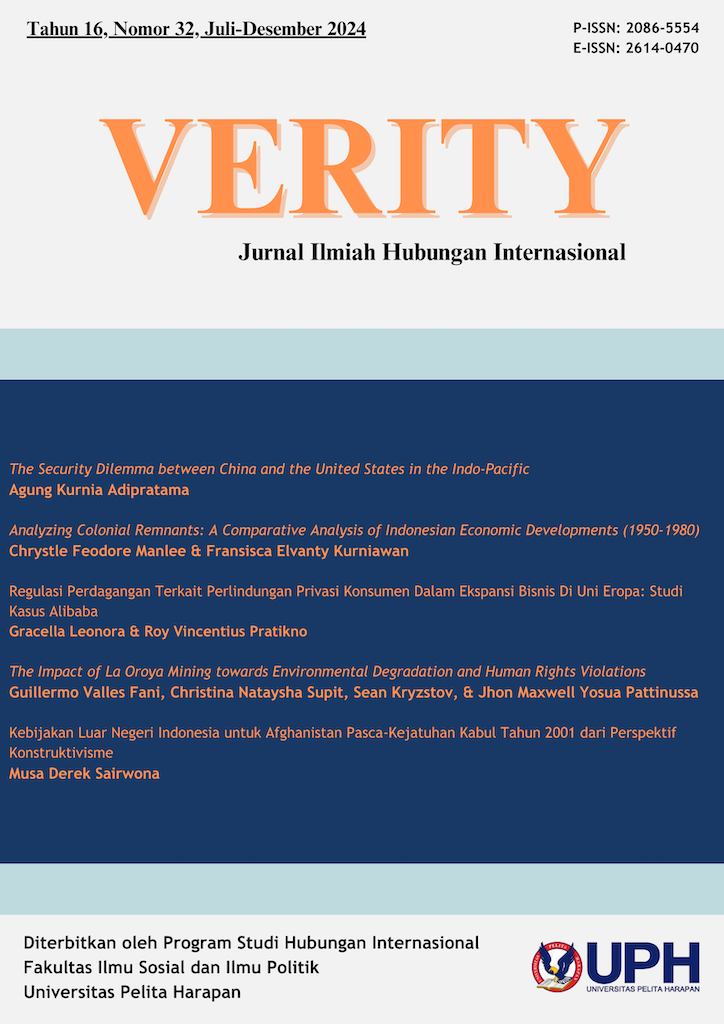DILEMA KEAMANAN ANTARA TIONGKOK DAN AMERIKA SERIKAT DI KAWASAN INDO-PACIFIC
DOI:
https://doi.org/10.19166/verity.v16i32.9098Kata Kunci:
China, United States, Security Dilemma, Indo-Pacific, Dilema Keamanan, Tiongkok, Amerika Serikat, Indo-PasifikAbstrak
Pertumbuhan ekonomi Tiongkok yang luar biasa dari tahun 1978 hingga 2010-an telah memungkinkan Beijing untuk memperbesar kekuatan militernya. Hal ini telah membuat Tiongkok menjadi lebih makmur dan lebih kuat dari sebelumnya. Hal ini juga menggeser keseimbangan kekuatan di kawasan Indo-Pasifik, terutama ketika Amerika Serikat telah menjadi kekuatan dominan sejak berakhirnya Perang Dingin. Selama tahun yang berbeda Amerika Serikat memiliki persepsi yang berbeda dalam mengomentari kebangkitan Tiongkok. Sejak tahun 2020, hubungan antara kedua negara telah meruncing ketika Menteri Luar Negeri Tiongkok saat itu Wang Yi menyebutkan munculnya kembali mentalitas "Perang Dingin". Esai ini menggunakan contoh dari studi kasus dan interaksi antara pemimpin dan aktor sosial. Esai ini akan membahas secara luas tentang kebangkitan Tiongkok dan reaksi Amerika Serikat terhadapnya. Lebih jauh, akan dijelaskan bagaimana dilema keamanan antara kedua negara terjadi yang berasal dari dua faktor yang disebutkan di atas. Tulisan ini menemukan bahwa kebangkitan Tiongkok yang secara terbukti menggeser keseimbangan kekuatan adalah melalui hadirnya militer Tiongkok di Laut Tiongkok Selatan. Tiongkok telah menggunakan kekuatan militer, diplomatik, dan ekonomi untuk memengaruhi realitas di lapangan. Ini adalah realitas yang harus diterima Amerika Serikat dengan sukarela dan upaya mengubah arah keseimbangan kekuatan telah menjadi norma bagi Washington. Pada ujung tulisan ini menyimpulkan bahwa dilema keamanan terjadi pada kedua negara karena keduanya saling curiga.Referensi
Archives, K. C. (1974). Dispute over Paracel and Spratly Islands. - Naval Clash off Paracels.
Chinese Occupation of Parcel Archipelago. Keeping’s Record of World Events, 20.
Benvenuti, A., Chung, C.-P., Khoo, N., & Tan, A. T. (2022). Historical drivers of China’s foreign policy. China’s Foreign Policy, 32–47. doi: 10.4324/9781003088288-4.
Berg, B. L. (2001). Qualitative Research Methods for The Social Sciences. Needham Heights,
MA: Allyn & Bacon.
Creswell, J. (2003). Research design - qualitative, quantitative, and mixed method
approaches John W. Creswell. Thousand Oaks, CA: Sage Publications.
Ding, A. S., & Panda, J. P. (2021). Chinese Politics and Foreign Policy under Xi Jinping.
Oxford: Routledge Studies on Think Asia.
Folly, M. H. (2000). Cold War history. Houndmills, Basingstoke, Hampshire: Macmillan
Press.
Guan, A. C. (1999). The South China Sea Dispute Re-visited. Institute Defence and Strategic
Studies.
Imannurdin, Y., Sudiarso, A., & Sianturi , D. (2024). The Impact of The AUKUS Alliance on
China’s Influence in The Indo-Pacific Region. International Journal of Humanities
Education and Social Sciences, 3(5). doi: https://doi.org/10.55227/ijhess.v3i5.976.
Mastanduno, M. (2023). Realist Theories and US Foreign Policy in the Indo-Pacific. The
Routledge Handbook of US Foreign Policy in the Indo-Pacific.
Masuda, M., & Mattelaer, A. (2024). The Long Shadow? China’s Military Rise in the Indo-
Pacific and its Global Implications. Centre for Security, Diplomacy and Strategy
Policy Brief, 18.
McLaughlin, M. (2020). U.S. Strategy in the South China Sea. American Security Project.
Mearsheimer, J. J. (2014). The Tragedy of Great Power Politics. New York, NY: W.W.
Norton & Company.
Myers, L. (2023). China’s Economic Security Challenge: Difficulties Overcoming the
Malacca Dilemma. Georgetown Journal of International Affairs.
Parker, J. (2023). Not Just Another Naval Exercise: Malabar’s Vital Messaging. Australian
Strategic Policy Institute.
Rim, H. J., & Platte, J. E. (2023). Indo-Pacific Strategies and Foreign Policy Challenges:
The US-china strategic competition. London: Routledge, Taylor & Francis Group.
Ross, R. S. (2012). The Problem with the Pivot: Obama’s New Asia Policy is Unnecessary
and Counterproductive. Council on Foreign Relations, 91(6), 70–82.
Ross, R. S. (2013). US Grand Strategy, the Rise of China, and US National Security Strategy
for East Asia. Strategic Studies Quaterly, 7(2).
Scott, D. (2018). The Indo-Pacific in US Strategy: Responding to Power Shifts. NATO
Defense College, 3(2), 19–43.
Scott, D. (2019). China’s Indo-Pacific Strategy: The Problems of Success. Journal of
Territorial and Maritime Studies, 6(2), 94–113.
Smith, S. A. (2021). The Quad in the Indo-Pacific: What to Know. Council on Foreign
Relations.
State, U. S. D. of. (2017). President Trump releases National Security Strategy - United
States Department of State. Retrieved from https://2017-2021.state.gov/presidenttrump-
releases-national-security-strategy/.
United States, G. of. (2022). Indo-Pacific strategy. Retrieved from
https://www.whitehouse.gov/wp-content/uploads/2022/02/U.S.-Indo-Pacific-
Strategy.pdf.
Walt, S. (2023). Does anyone still understand the “security dilemma”? Retrieved from
https://foreignpolicy.com/2022/07/26/misperception-security-dilemma-ir-theoryrussia-
ukraine/.
Walters, R. (2023). China’s Military Puts Indo-Pacific on Edge. GIS Report Online.
Whiting, A. (2018). China’s role in the Vietnam War. The American War in Vietnam, 71–76.
doi: 10.7591/9781501719462-005.
Zoellick, R. B. (2001). National Committee on U.S.-China Relations. In U.S. Department of
State Archive (pp. 0–10). New York: U.S. Department of State Archive.
Unduhan
Diterbitkan
Terbitan
Bagian
Lisensi
Hak Cipta (c) 2024 Agung Kurnia Adipratama

Artikel ini berlisensiCreative Commons Attribution-ShareAlike 4.0 International License.
Authors who publish with this journal agree to the following terms:
1) Authors retain copyright and grant the journal right of first publication with the work simultaneously licensed under a Creative Commons Attribution License (CC-BY-SA 4.0) that allows others to share the work with an acknowledgement of the work's authorship and initial publication in this journal.
2) Authors are able to enter into separate, additional contractual arrangements for the non-exclusive distribution of the journal's published version of the work (e.g., post it to an institutional repository or publish it in a book), with an acknowledgement of its initial publication in this journal.
3) Authors are permitted and encouraged to post their work online (e.g., in institutional repositories or on their website). The final published PDF should be used and bibliographic details that credit the publication in this journal should be included.


